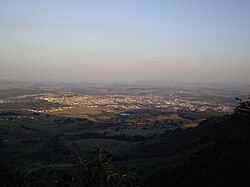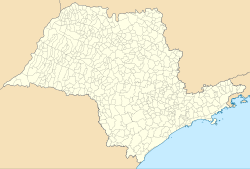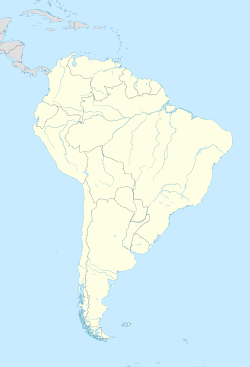São Pedro is a municipality in the state of São Paulo in Brazil. The population is of 35,980 (2020) in an area of 611.278 km2 (236.02 sq mi).[3]
São Pedro | |
|---|---|
| Municipality of the Touristic Resort of São Pedro Município da Estância Turística de São Pedro | |
 City as seen near the Christ's Belvedere | |
| Motto(s): Fide et labore patriae magnitudo (Latin for With faith and work, we magnify the country) | |
| Anthem: Exaltação a São Pedro | |
 Interactive map outlining São Pedro | |
| Coordinates: 22°32′55″S 47°54′50″W / 22.54861°S 47.91389°W | |
| Country | |
| Region | Southeast |
| State | |
| Named for | Saint Peter |
| Government | |
| • Mayor | Thiago Silva (PSDB) |
| • City council | Members |
| Area | |
• Total | 611.278 km2 (236.016 sq mi) |
| Elevation | 561.01 m (1,840.58 ft) |
| Population (2020 [6]) | |
• Total | 35,980 |
| • Rank | 988th, Brazil |
| • Density | 51.98/km2 (134.6/sq mi) |
| Demonym | são-pedrense[4][7] |
| Ethnicity | |
| • White | 77.61% (24,572 inhabitants) |
| • Brown | 19.63% (6,216 inhabitants) |
| • Black | 2.29% (724 inhabitants) |
| • Yellow | 0.39% (124 inhabitants) |
| • Indian | 0.08% (26 inhabitants) |
| Time zone | UTC-3 (BRT) |
| • Summer (DST) | UTC-2 (BRST) |
| Postal code | 13520-000 |
| Area code | 19[10] |
| HDI (2010)[11] | 0.755 – high |
| Website | www |
History
editThe brothers Joaquim, José and Luiz Teixeira de Barros, who came from Itu, bought the Pinheiros Sesmaria where São Pedro is today. They brought with them: slaves, employees and family members. The Picadão, a road that led from São Paulo to Cuiabá, passed through this same area and where the historic center is today was the so-called Pouso do Pidadão, which was looked after by the cattle driver Floriano de Costa Pereira, known as Florianão.
Of the Teixeira de Barros brothers, Joaquim was considered the “settler” and, as was customary, he built a small chapel whose patron saint was Saint Sebastian. Authorized by the Catholic Church, it was given the name Capela do Picadão.
The name and patron saint did not please the population and it was soon changed to Capela de São Pedro. The fertility of the land attracted other families, and in 1864 the settlement was elevated to the status of Parish. In 1867, the first priest, Father Aurélio Votta, an Italian, arrived. In 1879, the Baron of Iguape, Captain Veríssimo Antônio da Silva Prado, who settled here as a farmer, managed to raise the status of a town. Later, in 1881, he managed to separate Piracicaba from the city and, in 1882, to the district, and the first judge, João Baptista Pinto de Toledo, arrived.
The Italian immigration period of 1890 and the production of coffee gave the municipality a boost.
The railroad branch arrived in 1893. During this coffee period, the Santa Casa de Misericórdia, cemetery, school, jail, city hall and chamber were established, in addition to the main church.
In the 1920s, the search for oil discovered water sources and the beginning of Termas de São Pedro, today Águas de São Pedro, which was emancipated in the 1940s. Around 1934, the then directors of Companhia Petróleos do Brasil, created by Monteiro Lobato in 1931, Ângelo Balloni and Vittorio Miglieta, coordinated the installation of the Balloni II well, which became a landmark for being considered the deepest drilled well reached in Brazil (1,815 m). The rig remains in place to this day.[12]
Geography
editClimate
editAccording to the Köppen climate classification São Pedro has a tropical savanna climate.[13]
| Climate data for São Pedro, São Paulo | |||||||||||||
|---|---|---|---|---|---|---|---|---|---|---|---|---|---|
| Month | Jan | Feb | Mar | Apr | May | Jun | Jul | Aug | Sep | Oct | Nov | Dec | Year |
| Mean daily maximum °C (°F) | 30.3 (86.5) |
30.4 (86.7) |
30.0 (86.0) |
28.4 (83.1) |
26.4 (79.5) |
25.2 (77.4) |
25.5 (77.9) |
27.7 (81.9) |
28.6 (83.5) |
29.1 (84.4) |
29.6 (85.3) |
29.6 (85.3) |
28.4 (83.1) |
| Daily mean °C (°F) | 24.6 (76.3) |
24.8 (76.6) |
24.2 (75.6) |
22.0 (71.6) |
19.7 (67.5) |
18.4 (65.1) |
18.2 (64.8) |
20.0 (68.0) |
21.5 (70.7) |
22.6 (72.7) |
23.3 (73.9) |
23.9 (75.0) |
21.9 (71.4) |
| Mean daily minimum °C (°F) | 18.9 (66.0) |
19.1 (66.4) |
18.4 (65.1) |
15.7 (60.3) |
13.0 (55.4) |
11.6 (52.9) |
11.0 (51.8) |
12.4 (54.3) |
14.4 (57.9) |
16.1 (61.0) |
17.0 (62.6) |
18.3 (64.9) |
15.5 (59.9) |
| Average precipitation mm (inches) | 221.5 (8.72) |
191.2 (7.53) |
149.2 (5.87) |
71.8 (2.83) |
62.3 (2.45) |
44.1 (1.74) |
26.7 (1.05) |
27.1 (1.07) |
64.3 (2.53) |
124.0 (4.88) |
133.5 (5.26) |
191.8 (7.55) |
1,307.5 (51.48) |
| Source: Center for Meteorological and Climatic Researches Applied to Agriculture[13] | |||||||||||||
Parks and recreation
editInfrastructure
editTransportation
editThe city is served by São Pedro Airport.
Utilities
editWater is provided by the Autonomous Service of Water and Sewage of São Pedro (SAAESP).[14]
Media
editIn telecommunications, the city was served by Companhia Telefônica Brasileira until 1973, when it began to be served by Telecomunicações de São Paulo.[15] In July 1998, this company was acquired by Telefónica, which adopted the Vivo brand in 2012.[16]
The company is currently an operator of cell phones, fixed lines, internet (fiber optics/4G) and television (satellite and cable).[16]
Religion
editChristianity is present in the city as follows:
Catholic Church
editThe Catholic church in the municipality is part of the Roman Catholic Diocese of Piracicaba.[17]
Protestant Church
editThe most diverse evangelical beliefs are present in the city, mainly Pentecostal, including the Assemblies of God in Brazil (the largest evangelical church in the country),[18][19] Christian Congregation in Brazil,[20] among others. These denominations are growing more and more throughout Brazil.
References
edit- ^ "Prefeitura de São Pedro | Gestão Atual" [São Pedro City Hall | Current Management]. São Pedro City Hall (in Portuguese). Retrieved 17 March 2019.
- ^ "17ª Legislatura" [17th Legislature]. São Pedro Municipal Council (in Portuguese). SINO Informática. Retrieved 17 March 2019.
- ^ a b "Official Territorial Area". Brazilian Institute of Geography and Statistics (IBGE). Retrieved 17 March 2019.
- ^ a b "IBGE | Brasil em Síntese | São Paulo | São Pedro | Panorama" [IBGE | Brazil in Brief | São Paulo | São Pedro | Panorama]. Brazilian Institute of Geography and Statistics (IBGE) (in Portuguese). Retrieved 17 March 2019.
- ^ "BR Localidades 2010 v1" [BR Locations 2010 v1] (MDB). Brazilian Institute of Geography and Statistics (IBGE) (in Portuguese). Retrieved 17 March 2019.
- ^ IBGE 2020
- ^ "Significado de são-pedrense" [Meaning of são-pedrense]. Caldas Aulete Online Dictionary (in Portuguese). Lexikon Editora Digital. Retrieved 17 March 2019.
- ^ "IBGE | Brasil em Síntese | São Paulo | São Pedro | Pesquisa | Censo | Universo - Características da população e dos domicílios" [IBGE | Brazil in Brief | São Paulo | São Pedro | Research | Census | Universe - Characteristics of population and households]. Brazilian Institute of Geography and Statistics (IBGE) (in Portuguese). Retrieved 17 March 2019.
- ^ "Tabela 2093 – População residente por cor ou raça, sexo, situação do domicílio e grupos de idade – Amostra – Características Gerais da População" [Table 2093 – Resident population by color or race, sex, state of domicile and age groups – Sample – General Characteristics of the Population] (in Portuguese). IBGE System of Automatic Recovery (SIDRA). Retrieved 17 March 2019.
- ^ "CÓDIGOS DE SÃO PAULO" [SÃO PAULO CODES] (PDF). National Agency of Telecommunications (in Portuguese). Archived from the original (PDF) on 30 June 2016. Retrieved 17 March 2019.
- ^ "Ranking IDHM Municípios 2010" [MHDI Ranking Municipalities 2010]. United Nations Development Programme Brazil (in Portuguese). Retrieved 17 March 2019.
- ^ saopedro.net.br. "saopedro.net.br | Guia de empresas e serviços em São Pedro". saopedro.net.br (in Portuguese). Retrieved 2024-12-11.
- ^ a b "Clima dos Municípios Paulistas / São Pedro" [Climate of São Paulo State Municipalities / Águas de São Pedro]. Center for Meteorological and Climatic Researches Applied to Agriculture - Unicamp (in Portuguese). State University of Campinas. Archived from the original on 11 July 2017. Retrieved 17 March 2019.
- ^ "APRESENTAÇÃO" [PRESENTATION]. SAAESP (in Portuguese). Retrieved 8 May 2019.
- ^ "Creation of Telesp - April 12, 1973". www.imprensaoficial.com.br (in Portuguese). Retrieved 2024-05-27.
- ^ a b "Our History - Telefônica RI". Telefônica. Retrieved 2024-05-27.
- ^ "São Paulo (Archdiocese) [Catholic-Hierarchy]". www.catholic-hierarchy.org. Retrieved 2024-06-22.
- ^ "Campos Eclesiásticos". CONFRADESP (in Portuguese). 2018-12-10. Retrieved 2024-06-22.
- ^ "Arquivos: Locais". Assembleia de Deus Belém – Sede (in Portuguese). Retrieved 2024-06-22.
- ^ "Localidade - Congregação Cristã no Brasil". congregacaocristanobrasil.org.br (in Portuguese). Retrieved 2024-06-22.
External links
edit- (in Portuguese) Prefeitura de São Pedro The official website of São Pedro.
- (in Portuguese) Câmara Municipal de São Pedro São Pedro City Council website.
- (in Portuguese) Estância Turística de São Pedro A tourism website about São Pedro.




